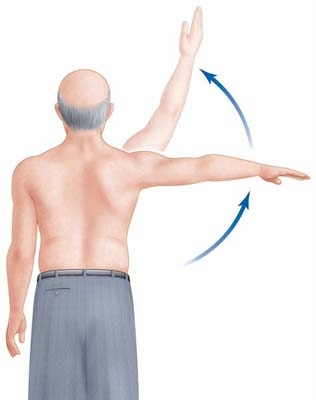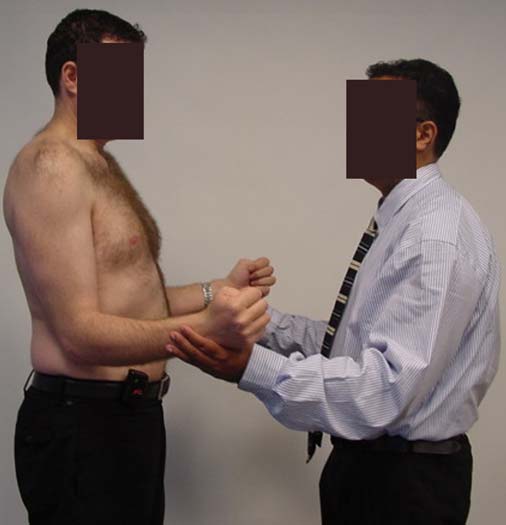Test Item Cluster - Full-Thickness Rotator Cuff Tear: Difference between revisions
No edit summary |
Evan Thomas (talk | contribs) mNo edit summary |
||
| Line 2: | Line 2: | ||
'''Original Editor '''- [[User:Jun Cesar Atienza|Jun Cesar Atienza]] | '''Original Editor '''- [[User:Jun Cesar Atienza|Jun Cesar Atienza]] | ||
'''Top Contributors''' - {{Special:Contributors/{{FULLPAGENAME}}}} | '''Top Contributors''' - {{Special:Contributors/{{FULLPAGENAME}}}} | ||
</div> | </div> | ||
To test the presence of a shoulder full-thickness rotator cuff tear using the [[Codman's Test|Drop-Arm Sign]], | == Purpose == | ||
To test the presence of a shoulder full-thickness rotator cuff tear using the [[Codman's Test|Drop-Arm Sign]], [[Painful Arc|Painful Arc Sign]], and the [[Infraspinatus Test|Infraspinatus Muscle Test]].<br> | |||
== Evidence == | == Evidence == | ||
Based on the Park et al<ref name="Park">Park HB, Yokota A, Gill HS, El RG, McFarland EG. Diagnostic accuracy of clinical tests for the different degrees of subacromial impingement syndrome. J Bone Joint Surg AmfckLR2005 July;87(7):1446-55.</ref> study, the combination of the following 3 special tests have produced the highest post-test probability to diagnose a full-thickness rotator cuff tear: | Based on the Park et al<ref name="Park">Park HB, Yokota A, Gill HS, El RG, McFarland EG. Diagnostic accuracy of clinical tests for the different degrees of subacromial impingement syndrome. J Bone Joint Surg AmfckLR2005 July;87(7):1446-55.</ref> study, the combination of the following 3 special tests have produced the highest post-test probability to diagnose a full-thickness rotator cuff tear: | ||
#The Drop-Arm Sign | #The Drop-Arm Sign | ||
#The Painful Arc Sign | #The Painful Arc Sign | ||
#Infraspinatus Muscle Test | #Infraspinatus Muscle Test | ||
The study concluded that if all 3 tests were positive, the | The study concluded that if all 3 tests were positive, the probability of the patient having a full-thickness rotator cuff tear is 91%.<ref name="Park"/><br> | ||
== Description and Illustrations == | |||
<u>The Drop-Arm Sign</u> | <u>The Drop-Arm Sign</u> | ||
Patient actively elevates the arm in the scapular plane and then slowly reverses the motion. A positive test is defined as the patient experiencing pain during the activity or that the arm suddenly drops. | Patient actively elevates the arm in the scapular plane and then slowly reverses the motion. A positive test is defined as the patient experiencing pain during the activity or that the arm suddenly drops.<br> | ||
<u>The Painful Arc Sign </u>(Fig 1) | |||
Patient fully elevates the arm along the scapular plane and then slowly reverses the motion. If patient experiences pain between 60° and 120° of range of motion, the test is considered positive.<br> | |||
<u>[[Image:Painful arc.jpg|Image:Painful_arc.jpg]]</u> | <u>[[Image:Painful arc.jpg|Image:Painful_arc.jpg]]</u> | ||
''Figure 1 (couresty of [http://www.maitrise-orthop.com/photos/168/cdumontier_doursounian_miseaupoint_1010/fig14dumontier.jpg http://www.maitrise-orthop.com])'' | ''Figure 1 (couresty of [http://www.maitrise-orthop.com/photos/168/cdumontier_doursounian_miseaupoint_1010/fig14dumontier.jpg http://www.maitrise-orthop.com])'' <br> | ||
<br | |||
<u>Infraspinatus Muscle Test </u>(Fig 2) | <u>Infraspinatus Muscle Test </u>(Fig 2) | ||
| Line 44: | Line 40: | ||
''Figure 2 (taken directly from Park et al''<ref name="Park"/>)<br> | ''Figure 2 (taken directly from Park et al''<ref name="Park"/>)<br> | ||
== References == | == References == | ||
<references /> | <references /> | ||
[[Category:Assessment]] [[Category: | [[Category:Assessment]] [[Category:Special_Tests]] [[Category:Shoulder]] [[Category:Shoulder Special Tests]] [[Category:Musculoskeletal/Orthopaedics]] [[Category:EIM_Residency_Project]] | ||
Revision as of 06:52, 6 December 2017
Original Editor - Jun Cesar Atienza
Top Contributors - Admin, Jun Cesar Atienza, Naomi O'Reilly, WikiSysop, Kim Jackson, 127.0.0.1, Selena Horner, Evan Thomas and Wanda van Niekerk
Purpose[edit | edit source]
To test the presence of a shoulder full-thickness rotator cuff tear using the Drop-Arm Sign, Painful Arc Sign, and the Infraspinatus Muscle Test.
Evidence[edit | edit source]
Based on the Park et al[1] study, the combination of the following 3 special tests have produced the highest post-test probability to diagnose a full-thickness rotator cuff tear:
- The Drop-Arm Sign
- The Painful Arc Sign
- Infraspinatus Muscle Test
The study concluded that if all 3 tests were positive, the probability of the patient having a full-thickness rotator cuff tear is 91%.[1]
Description and Illustrations[edit | edit source]
The Drop-Arm Sign
Patient actively elevates the arm in the scapular plane and then slowly reverses the motion. A positive test is defined as the patient experiencing pain during the activity or that the arm suddenly drops.
The Painful Arc Sign (Fig 1)
Patient fully elevates the arm along the scapular plane and then slowly reverses the motion. If patient experiences pain between 60° and 120° of range of motion, the test is considered positive.
Figure 1 (couresty of http://www.maitrise-orthop.com)
Infraspinatus Muscle Test (Fig 2)
Arm is resting in neutral, the patient is instructed to flex elbow to 90° and resist against applied resistance mediall. If the patient is unable to resist the force or experiences pain, the test is considered positive.
Figure 2 (taken directly from Park et al[1])








